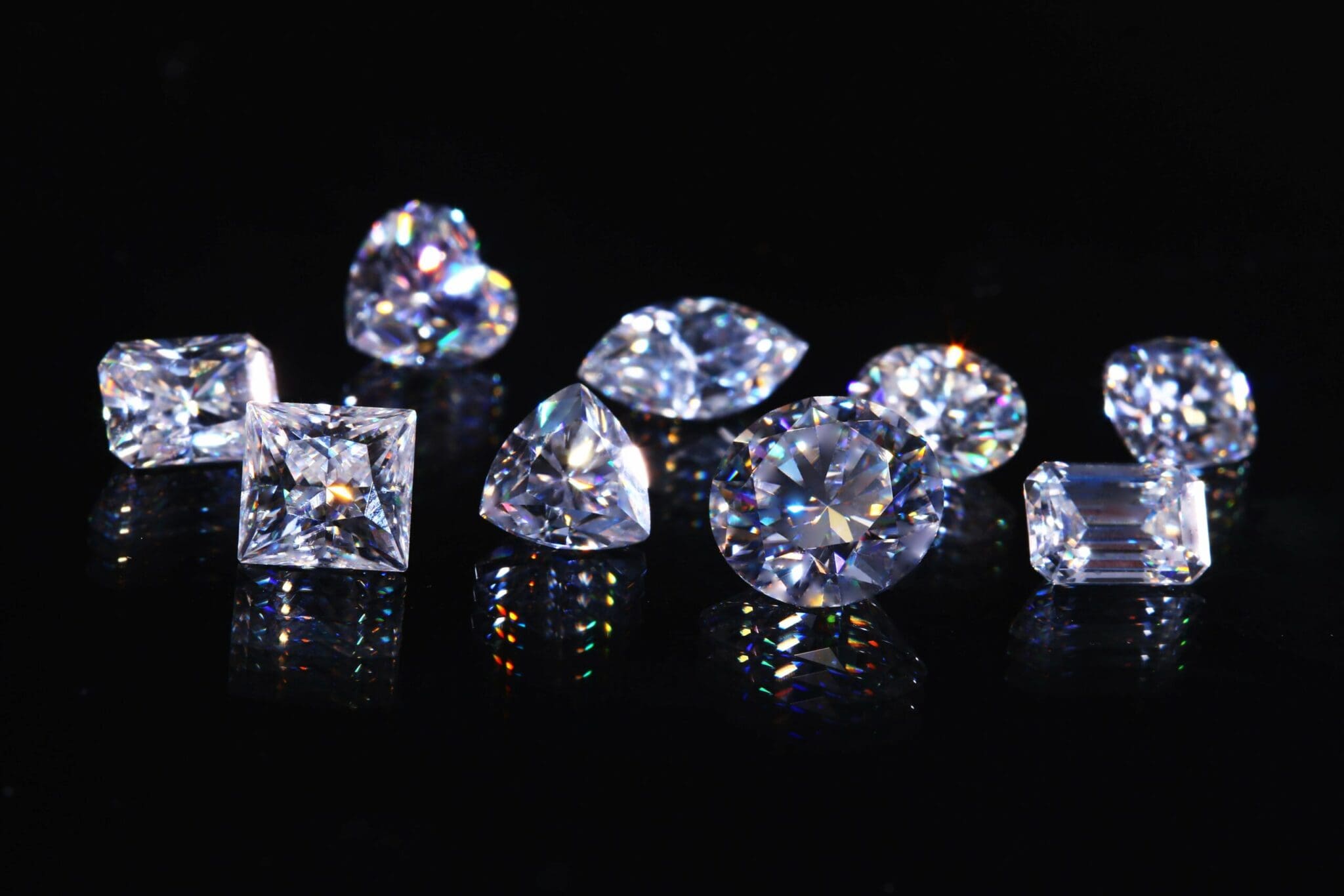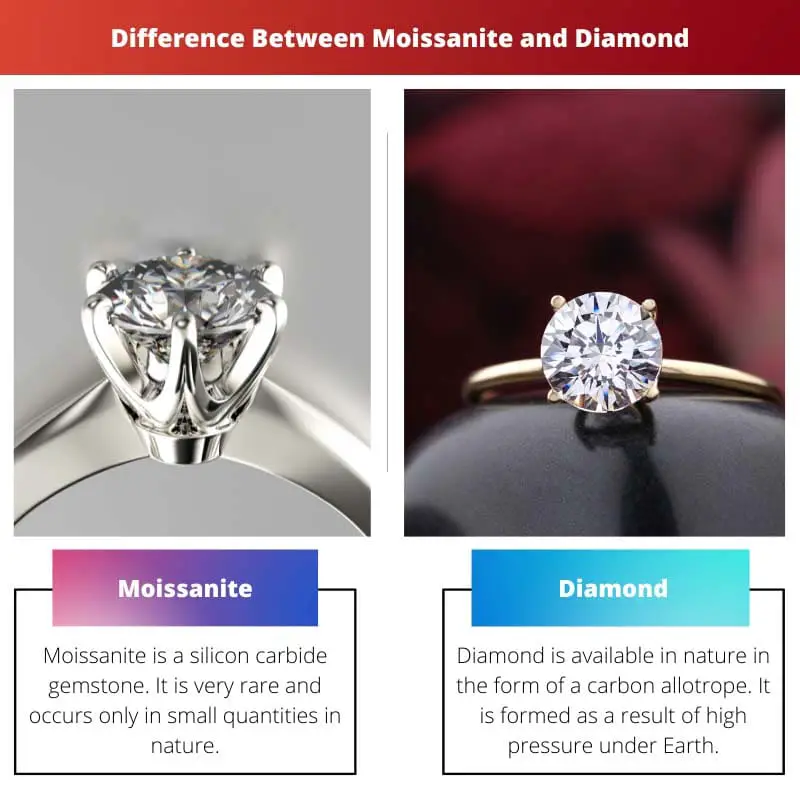Gemstones are available in nature in the form of mineral crystals. They are taken from these sources and polished. These polished gemstones are used in the manufacturing of Jewels.
These gemstones need not be mineral crystals essentially, organic compounds like pearl and rocks like lapis lazuli are also used in precious ornaments. Diamond is one of the expensive gemstones.
Key Takeaways
- Moissanite is a lab-created gemstone that closely resembles a diamond but costs less.
- Diamonds are natural gemstones valued for their beauty, rarity, and durability.
- Moissanite is a popular alternative for those seeking an affordable and ethical option.
Moissanite vs Diamond
Moissanite is a lab-created gemstone made of silicon carbide, which is more affordable than diamonds. Diamonds are natural gems made of carbon and are more durable and expensive than moissanite. They are formed deep within the earth and are known for their hardness, brilliance, and rarity.

Moissanite is a silicon carbide gemstone. It is very rare and occurs only in small quantities in nature. Since it is very hard to obtain it from natural sources it is manufactured artificially in laboratories.
A French chemist named Henry Moissan discovered it in 1893. Besides, aesthetic purposes it is also used in industries due to its hardness and optical properties.
Diamond is available in nature in the form of a carbon allotrope. It is formed as a result of high pressure under Earth. Diamond can be made impure even by the addition of a small number of impurities.
The presence of certain elements gives diamonds certain colors. For example presence of nitrogen gives it a yellow color. Radiation exposure can give it a green, pink, or red color.
Comparison Table
| Parameters of Comparison | Moissanite | Diamond |
|---|---|---|
| Compound | Silicon carbide | Carbon |
| Source | Synthesized artificially in laboratories | Taken from its natural sources and cut |
| Price | Affordable | Expensive |
| Clarity | Very clear with no flaws | Clear but many have imperfections |
| Uses | Used in semiconductor, sandblasting, Jewel making | Drilling various objects and in ornament making |
What is Moissanite?
French chemist Moissan discovered Moissanite while he was working on the rock samples collected from a meteor crater in Arizona.
Initially, he thought it was a diamond but after 10 years he found it to be Silicon carbide and not a diamond. But, the artificial synthesis of this compound has begun two years before the discovery by Moissan.
This crystal was named after its discoverer Moissan as Moissanite.
Then the natural occurrence of Moissanite was searched in various locations but in vain till the 1950s. In 1958 it was again found in Wyoming at the Green River formation.
It was also found along with Kimberlite in Yakutia. It is very rarely found in nature. Presolar grains of Moissanite is also found in carbonaceous meteorites.
Some studies conducted on the Moissanite crystals obtained from the Murchison meteorite showed that it was extraterrestrial in origin. That is it has been formed outside the solar system.
The silicon carbide particles were formed around some stars from their infrared spectra. The structure of the crystal is made up of strong covalent bonds. This lets the crystal withstand high pressure.
All the Moissanite now available in the market is made artificially. Its laboratory production started in 1891 for using it as a substitute for Diamond in cutting. It is also used in semiconductor devices.
Only in 1998, it was introduced to the jewelry industry. It is available under the trademark names aurora, forever classic, forever one, etc. It is used as an alternative for Diamond.

What is a Diamond?
Diamonds take billions of years to form and are formed very deep inside the earth. The principle of their formation is under high pressure the fluids containing carbon mix with the minerals and convert them into diamonds.
This reaction would have happened billions of years ago but these substances were brought up by volcanic eruptions recently in the past.
Synthetic diamonds are formed in laboratories from pure carbon subjected to high temperature and pressure. Substances that imitate diamond can be made using cubic zirconia.
However, all these types can be differentiated by optical techniques. Diamonds are very hard that they can be cut or even scratched only by another Diamond.
Because of its hardness, it remains polished and does not lose its luster easily. It is suitable for everyday wear jewels because it is not easily scratchable. It is used in marriage rings and engagement rings.
Pure diamond should appear colorless. Colors develop only due to impurities. The most common impurity found in Diamond is Nitrogen which gives it a yellow color.
To make rare diamonds the impurities are enhanced. Black diamonds are one of the rarest. They are not black but they have a large quantity of dark inclusion. These inclusions give them their black color. Clarity defines the quality of Diamonds.
They are rare on Earth but common in space. The conditions in space are favorable for the formation of Diamonds.

Main Differences Between Moissanite and Diamond
- Moissanite gives more fire that is, it shows more colored flashes compared to white or colorless flashes. While Diamond gives more brilliance which is the white flashes
- Moissanites are perfect and have good clarity but Diamonds are natural so they contain some visible imperfections
- Moissanites are rare in nature and are manufactured in laboratories but Diamonds are mostly obtained from natural sources.
- Moissanite is not hard like Diamond it is the second hardest thing while Diamond tops the list when it comes to hardness. Diamond has a value of 10 on the mohrs hardness scale while Moissanite only has 9.25 to 9.5
- Moissanite is less valuable than diamond and available at a lower price but, Diamond is very expensive since it is natural and of high quality

- https://science.sciencemag.org/content/290/5492/783.abstract
- https://royalsocietypublishing.org/doi/abs/10.1098/rspa.1913.0084
